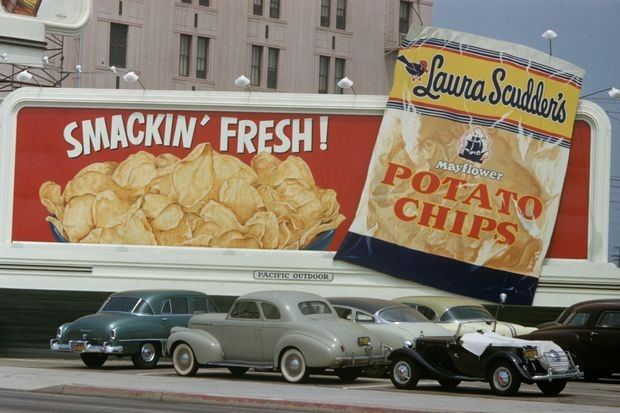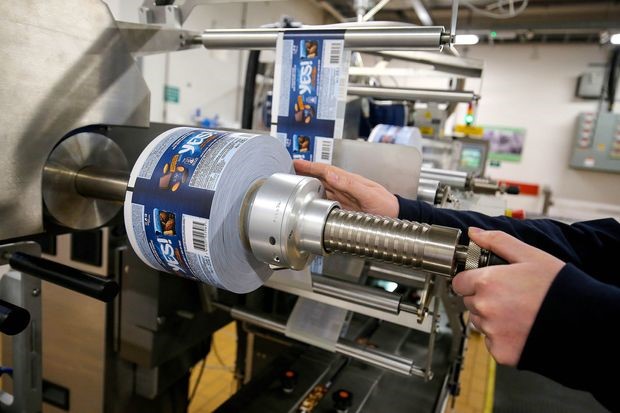
Yes! snack bars wrapped in recyclable paper rolled off a production line at a Nestlé research and development facility in York, U.K., last year.
PHOTO: NIGEL RODDIS/PA WIRE/ZUMA PRESS
Consumer-goods companies are increasingly substituting paper for plastic packaging but face a big challenge: how to stop products from going stale or soggy.
Slashing plastic waste is a major concern for makers of food, drinks, cleaning sprays and personal-care products, as they grapple with regulatory pressure and scrutiny from consumers. In response, companies like Nestlé SA and Unilever UL are turning to paper as an alternative to hard-to-recycle plastics.
Executives say they opt for paper because it is made from a renewable source and is easily recyclable and consumers aren’t confused about which bin it goes in. Paper and cardboard are steadily replacing plastic straws, bags, fruit trays and shrink wrap for drinks.
That trend is forecast to accelerate, particularly in Europe, which is implementing new regulation to curb plastic waste, including a U.K. tax on plastic packaging. UBS estimates paper could capture 11% of plastic packaging’s market share in Europe—worth about $9.4 billion—between next year and 2031, in areas like food, drink and personal care. Globally, it estimates paper has a $38.7 billion market opportunity to replace plastic over this period.

California entrepreneur Laura Scudder sold potato chips in waxed paper bags, helping them stay crisp longer than when sold from barrels.
PHOTO: ROBERT LANDAU/CORBIS/GETTY IMAGES
“There’s a lot of momentum behind single-use plastics replacement,” said Colin McIntyre, head of paper and recycling at DS Smith PLC. The British paper maker says it has found 650 areas in which plastic can be replaced with paper-based packaging. “This is a really, really key focus for us,” Mr. McIntyre said.
Before being elbowed aside by plastic after World War II, paper was the dominant packaging material for many consumer-goods products. One such product was potato chips: Laura Scudder, a California entrepreneur, packaged chips in waxed paper bags, which kept them fresher for longer compared with the big barrels they were previously dispensed from.
But paper comes with major drawbacks. It doesn’t have the protective properties that keep food fresh, making it unsuitable to replace some of the hardest-to-recycle plastics used for chip packets, baby-food pouches and produce bags.
“Plastics are highly functional. They’re water-resistant, grease-resistant, easy to seal,” said Patrick Lindner, chief innovation officer at WestRock Co., a paper-packaging maker based in Atlanta. “Getting paper to behave like plastic is a tremendous technological challenge.”
One burgeoning technology involves coating paper to make it resistant to oxygen, liquids, humidity and grease. But giving paper plasticlike properties can complicate paper recycling. Draft legislation in Europe threatens to regulate plastic-coated paper as single-use plastic.
Nestlé, the world’s biggest packaged-foods maker, has started using coated paper packets instead of ones layered with plastic and aluminum for its Yes! snack bars and some Nesquik cocoa powder. The coating is plastic but dissolves in the paper-recycling process, said Gerhard Niederreiter, head of Nestlé’s packaging institute. That distinguishes it from most paper cups and sandwich boxes whose tightly bonded plastic liners make them hard to recycle.
Last month, Nestlé began wrapping its Maggi bouillon cubes in paper, enhancing the coating used for Yes! and Nesquik to also be fat-resistant
But it still uses multilayer packaging containing plastic for more sensitive items, such as instant coffee or infant-nutrition products. It hasn’t found technology that would offer enough protection from oxygen and moisture and ensure nutrients don’t degrade.
“It’s a Holy Grail, this high barrier,” Mr. Niederreiter said.

Nestlé recently began selling its Maggi bouillon cubes in France in recyclable paper packaging.
PHOTO: NESTLE
Unilever last year began selling its Carte d’Or brand in a paper carton that has a cornstarch coating to preserve the ice cream in freezing and moist conditions. The coated carton can be recycled at paper mills or industrially composted, it says.
“We’re moving many of our products, which are today in multilayer plastic—which is evil because you cannot recycle it—into paper or recyclable plastics,” Hanneke Faber, head of Unilever’s food business, told investors after the Carte d’Or launch.
But so far changes by Unilever, Nestlé and others in the industry are limited to particular lines and only a few countries.
Executives say shelf life and climate are big hurdles to wider use of paper. Nestlé reduced the per-bag volume of Nesquik that is packaged in paper because it had roughly half the shelf life compared with plastic, Mr. Niederreiter said. Europe’s relatively mild humidity and temperatures are more conducive for paper packaging than parts of Asia and Africa, he added.
Swapping paper for plastic for nonfood items—for example, to wrap multipacks of cans or toilet paper—is less complicated, although investing in production lines to handle paper is expensive. Paper is harder to fold, less flexible and more easily torn than plastic.
Plastic makers say paper poses its own threats to the environment and uses more resources to produce. Deforestation, a continuing concern, could rise if companies turn to paper in a big way.
One alternative to coatings are easily removable plastic liners like those used in a bag-in-box version of Procter & Gamble Co. Tide laundry detergent. Smurfit Kappa Group, which developed the packaging, prefers liners to coatings, which it says can increase waste and raise costs for its paper mills.
“We have a very pure system with not a lot of waste that’s economically working and sustainable,” said Smurfit innovation head Arco Berkenbosch. “Any pollution that comes in there makes the system less efficient.”

Nestlé started using coated paper to wrap its Yes! snack bars instead of packets layered with plastic and aluminum.
PHOTO: NIGEL RODDIS/PA WIRE/ZUMA PRESS
Source: The Wall Street Journal, October 7, 2020 | Saabira Chaudhuri